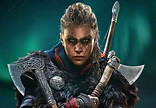







History
Female Vikings: The Real History
Save 10% on officially licensed Assassin's
Creed Origins merchandise with the code "TOWCB"
Top Stories
27/10/20 By Lauren Harris Edited by Ashlea Buckley
When the first trailer for Assassin’s Creed Valhalla released and fans were introduced to the protagonist, Eivor, who can be played as either male or female, it was the subject of much discussion. Fans debated over how realistic the concept of a female Viking warrior was. Could a female Eivor be historically accurate? Or was it simply a gameplay decision made for the benefit of representation and player choice? In this article, we look at the true history of women during the Viking era and the role they played in their society.
According to Judith Jesch, Professor of Viking Studies at the University of Nottingham and the author of Women in the Viking Age (1991), women could not be Vikings as the Old Norse word “vikingar” only applied to men. The idea of female Viking warriors being a historical fact seems to have originated with a DNA study into the remains found in a grave in Birka, Sweden, in 1889. For over one hundred years, the remains were assumed to be of a male warrior. However, in 2017, DNA proved that the bones belonged to a woman. The researchers then published their assessment that the deceased must have been a warrior woman. The reasoning for this was due to the possessions found in the grave, such as pieces of a chess-like board game. Items like this were often found in the graves of warriors, and so the assumption was made that this must have been a warrior. Vikings historians were quick to dispute this conclusion, however. For one, there was no concrete evidence that board games had any connection to warriors. Also, it was very possible that bones had been mixed together during burials, and that this was not specifically a warrior’s grave. Sadly, most scholars believe that female Viking warriors simply did not exist. However, that does not mean that women had no role in Viking society. Actually, research shows that Viking era women had a level of equality with men that most societies would not achieve for many, many years.
In Assassin's Creed Valhalla, players can let the Animus choose which perspective to view the memory stream from depending on its strength. This is to encourage fans to play as both characters, rather than as just one.
Women had a number of important roles in Viking society. Many of these involved work around the house and farm – but women were not simple housewives. In fact, they were responsible for all the wealth in their household. The women controlled the money and the keys to the property. If the men wanted to use either of these things, they would have to go to their wives first. Additionally, since the men were often away exploring, raiding, or voyaging, the women were in charge of making the decisions. They were the ones left behind to keep the economy flourishing and prevent the village from falling apart. In what was an incredibly progressive move for the time, women were allowed to have occupations outside of the home. They were traders, priestesses, and even rune masters. Often, women would produce textiles and sell them in the village. Sometimes, the power of a woman could overshadow her husband. Some men would admire their wives for this fiery personality, but others would feel emasculated. Regardless, society always respected a powerful woman.
Evidence of a powerful Viking era woman was found in a burial in Oseberg. Remains of a woman, assumed to be of nobility or even royalty, were found buried in a large ship. She was interred with carved wooden furniture, a tapestry, fine bedding, and household utensils. This suggested that she had power within the society and was respected by her peers.
Law was also much fairer to women in the Viking Age than in other periods of history. Women were able to inherit land from their parents, though less than their brothers would receive. A woman would also receive money from her groom upon marriage, of a similar value to the dowry she would present to him. Married couples in the Viking Age were able to divorce, a progressive concept in itself, and if they did, the woman would get to keep her own dowry and that of her groom. They were also free to remarry without judgement. Abuse of women was not tolerated in Viking society. Rape of a woman was a crime punishable by exile, and a woman could demand a divorce if her husband hit her three times. That said, female infidelity was not acceptable and was punished, though men were allowed to have mistresses.
Another way that Vikings showed their appreciation for the women in their lives was through rune stones. Whilst most rune stones were erected for men, many were also erected in memory of women. This shows that Vikings wanted people to remember their women and felt that they deserved the same memorial as the men.
Despite the historians suggesting that female Viking warriors did not exist, there are many stories in Norse literature of women riding into battle alongside the men. Where did these myths come from?
The Icelandic sagas with tales of Viking shield-maidens and Valkyries were written centuries after the Viking Age, which makes it difficult to believe the stories they tell. However, what these sagas do show is the way the Norse respected and admired strong women in their society. The women in these stories were depicted in various ways. Some were Valkyries sent by the god Odin to retrieve fallen warriors from the battlefield and bring them to Valhalla. Some were mortal but with supernatural powers, like fortune tellers and prophets. Others were regular humans who picked up a sword and shield and went into battle with their male counterparts. Famous female warriors in Norse literature include Sigrdrifa the Valkyrie, who appears in the poem Sigrdrífumál also featuring Sigurd the Dragonslayer.
While little historical evidence has been found to support the idea of Viking warrior women existing, there have been some accounts which could lend support to the theory. One is from an Irish history book written in the 12th century which speaks of a warrior named “The Red Maiden” who attacked Munster with a Viking fleet in the 10th century. Another is from 11th century Greek historian Johannes Skylitze who recorded that there were armed female Vikings among the warriors who attacked the Byzantines in Bulgaria in 971. As with the Icelandic sagas, though, the fact these sources were written hundreds of years after the Viking age makes the stories less credible.
Other evidence which could suggest female Viking warriors existed comes from two sets of remains found in Norway. One set was the skeleton of a woman around 20 years old who was buried with a complete set Viking weaponry. The other was a skeleton of a woman around 18 years old who had a full set of weaponry along with equipment for a horse. There is little reason for the women to be buried with these possessions unless they were important to them, suggesting that they could have been warriors themselves. However, under Viking law, a woman would gain all her husband’s belongings upon his death. It could be that these weapons belonged to their warrior husbands and were buried with the wives for sentimental reasons.
To conclude, historians believe that the existence of Viking warrior women is unlikely – and so too would be a character like female Eivor. However, it is clear that women held more power in Viking society than any other culture for years to come. Women were not subservient and they were free to make their own decisions in life. It is said that no one could tell a Viking era woman what to do. We have to wonder then if a woman wanted to be a Viking warrior, who was going to stop her? In that case, maybe there were female warriors lost to the annals of history – and maybe Eivor was one of them.
About the Author

Lauren is a online article writer who loves the Assassin's Creed franchise.
As a member of the AC Partnership Program, she will be writing regular articles for the AC community, and her work can now be found in the Community Hub.
Lauren is especially interested in Assassin's Creed lore, and will be exploring this more in future articles.
Lauren Harris
Eivor is a fierce Viking warrior, and the leader of the Raven Clan.
Available on Xbox Series X|S, Xbox One, PlayStation®4, Epic Games Store, Ubisoft Store on Windows PC, as well as on UPLAY+, and Stadia. Also coming to PlayStation®5.
Related Articles:
Viking Weaponry We Might See in Assassin's Creed Valhalla
Interview with Co-Dev Game Director Benoît Richer
Q&A with Game Director Eric Baptizat



















